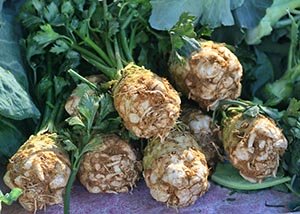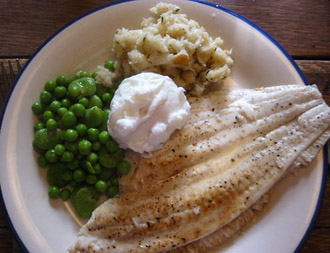Celeriac (root celery) Nutrition facts
Celeriac, also referred to as root-celery, is a closely related variant of common leaf celery. This vegetable is primarily cultivated for its delectable, gnarled subterranean root. Root celery finds significant popularity during the winter season and is utilized in various culinary preparations, such as mashes, soups, and stews, particularly in the rural areas of Eastern and North European regions.
From a botanical standpoint, it is classified within the Carrot or Apiaceae family and belongs to the Apium genus. Its scientific name is Apium graveolens var. rapaceum.
 |
| Fresh root celery in a market. Photo courtesy: nostri-imago |
Celeriac is a plant that typically follows a biennial growth pattern, although it can sometimes persist as a perennial. To thrive, it requires full sunlight and sufficient moisture in the soil. Its growth habit and overall appearance closely resemble that of leaf celery. However, unlike leaf celery, celeriac develops a large, gray, spherical tuber just beneath the soil's surface, which bears a resemblance to turnips. The plant's leaves resemble those of celery, with long, hollow petioles, although these leaves are seldom used in culinary recipes.
The celeriac root possesses an exterior characterized by a rough, knobbly surface adorned with small rootlets. Inside, its flesh is smooth and white, featuring a flavor reminiscent of celery. Typically, the root measures approximately 3-4 inches in diameter and weighs around 1-2 pounds.
Health benefits of Celeriac
Celeriac boasts a remarkably low calorie content, with just 42 calories in every 100g of its root, which is notably higher than that of leaf celery. Its velvety flesh is rich in an array of health-promoting plant nutrients, essential minerals, vitamins, and dietary fiber.
Similar to other vegetables in the Apiaceae family, such as carrot, celeriac is abundant in a variety of poly-acetylene antioxidants, including falcarinol, falcarindiol, panaxydiol, and methyl-falcarindiol.
Research studies conducted by scientists at the University of Newcastle at Tyne have demonstrated that these compounds possess anti-cancer properties, potentially offering protection against colon cancer and acute lymphoblastic leukemia (ALL).
Celeriac serves as an outstanding source of vitamin K, providing approximately 41 µg or 34% of the recommended daily intake in every 100g of its root. Vitamin K contributes to improved bone mineralization by stimulating osteoblastic activity in the bones. Additionally, research suggests its established role in protecting neuronal health in Alzheimer's disease patients.
The root is also a rich source of essential minerals, including phosphorus, iron, calcium, copper, and manganese. Phosphorus is essential for cell metabolism, maintaining the blood's buffering system, and supporting bone and teeth formation, while copper aids in bolstering immunity, preventing anemia, and supporting bone health.
Furthermore, celeriac contains valuable B-complex vitamins such as pyridoxine, pantothenic acid, niacin, riboflavin, and thiamin. Additionally, fresh celeriac root provides a moderate amount of vitamin C, with 8 mg per 100g.
| Principle | Nutrient Value | Percent of RDA |
|---|---|---|
| Energy | 42 Kcal | 2% |
| Carbohydrates | 9.20 g | 7% |
| Protein | 1.5 g | 3% |
| Total Fat | 0.30 g | 1% |
| Cholesterol | 0 mg | 0% |
| Dietary Fiber | 1.8 g | 5% |
| Vitamins | ||
| Folates | 8 µg | 2% |
| Niacin | 0.700 mg | 4% |
| Pantothenic acid | 0.352 mg | 6% |
| Pyridoxine | 0.165 mg | 13% |
| Riboflavin | 0.060 mg | 5% |
| Thiamin | 0.050 mg | 4% |
| Vitamin A | 0 IU | 0% |
| Vitamin C | 8 mg | 13% |
| Vitamin E | 0.36 mg | 2% |
| Vitamin K | 41 µg | 34% |
| Electrolytes | ||
| Sodium | 100 mg | 6.5% |
| Potassium | 300 mg | 6.5% |
| Minerals | ||
| Calcium | 43 mg | 4.3% |
| Copper | 0.070 mg | 8% |
| Iron | 0.70 mg | 9% |
| Magnesium | 20 mg | 5% |
| Manganese | 0.158 mg | 7% |
| Phosphorus | 115 mg | 16% |
| Zinc | 0.33 mg | 3% |
| Phytonutrients | ||
| Carotene-ß | 0 µg | -- |
| Crypto-xanthin-ß | 0 µg | -- |
| Lutein-zeaxanthin | 1 µg | -- |
Selection and storage
If you grow celeriac in your backyard, it should be ready for harvest by August but can remain available until December. In stores, you can usually find it from September to April.
When purchasing celeriac, opt for medium-sized tubers that are about 3-4 inches in diameter. Look for tubers with a smooth and even surface, as they are easier to peel and have a more subtle flavor. Avoid larger, over-matured roots and those with surface cracks.
Once you bring celeriac home, store it similarly to turnips and carrots. It has a good shelf life and can be stored for 3-4 months if kept between 0°C and 5°C with high relative humidity, making sure it doesn't dry out in between. Store it in a plastic bag in the vegetable compartment of your refrigerator, but avoid storing it in the deep freezer.
Preparation and serving methods
To prepare celeriac, start by scrubbing and washing the root under cold running water to remove any surface sand and soil. Afterward, pat it dry with an absorbent cloth. Trim the top end and base, and then proceed to cut the entire tuber into quarters or cubes. Use a thick knife to scrape off the outer skin.
Similar to potatoes, celeriac can turn brown when exposed to air. To prevent this, simply rub a slice of lemon or orange over the cut surface. You can then chop its white flesh into cubes or slices according to your preference before incorporating it into your recipes. Boiled celeriac can also be mashed and added to other vegetables.
Here are some serving tips:
 |
| Plaice served with green peas, broad beans and mashed celeriac. |
Celeriac can be employed in recipes much like other root vegetables, imparting a delicate celery flavor to dishes.
It can be used raw in salads, coleslaw, and as a garnish (grated) in dishes such as French celeriac remoulade.
When boiled and mashed, celeriac creates a delightful combination with mashed potatoes. This mixture pairs well with fish, meat, and other root vegetables like potatoes, beets, kohlrabi, turnips, and carrots, among others.
Root celery can also enhance soups, sauces, pies, and casseroles.
Safety profile
Celeriac contains several furanocoumarin compounds, including psoralen, bergapten, xanthotoxin, and isopimpinellin, which can potentially cause skin burns (photo-toxicity) in sensitive individuals. Additionally, like celery, it should be consumed in moderation by pregnant women.
Similarly, individuals taking diuretic medications and anti-coagulant medications should exercise caution when consuming this root. Please refer to this medical disclaimer for further information.
≻≻-Back to Vegetable from Celeriac. Visit here for an impressive list of vegetables with complete illustrations of their nutrition facts and health benefits.
≻≻-Back to Home page.
Further reading:
Refer Stanford School of Medicine Cancer information Page- Nutrition to Reduce Cancer Risk.